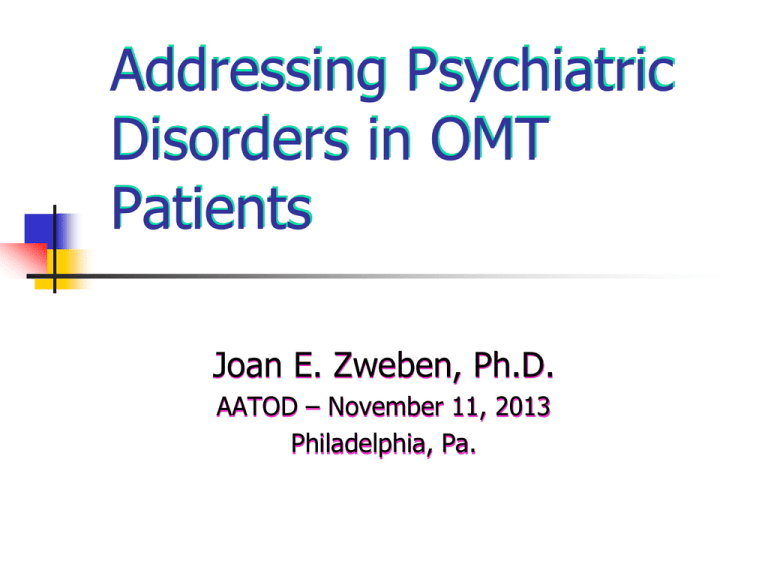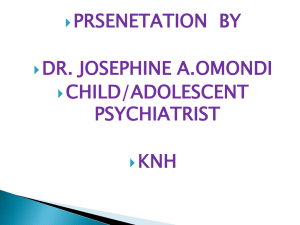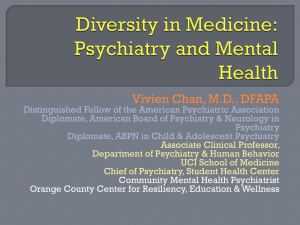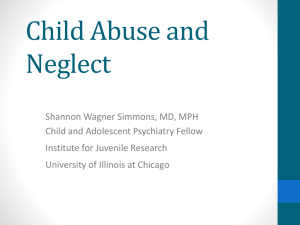
Addressing Psychiatric
Disorders in OMT
Patients
Joan E. Zweben, Ph.D.
AATOD – November 11, 2013
Philadelphia, Pa.
Overview
Guiding principles of programming
How untreated psychiatric conditions affect
recovery and quality of life
Basic counselor competencies
Distinguishing between substance-induced
symptoms and independent disorders
Psychosocial issues
Medication
Collaboration with physicians
Influences Promoting the
Paradigm Shift (1990’s)
Epidemiological data: ECA and NCS
Collaboration of federal agencies
Merging of local mental health and
substance abuse agencies
Intense interest in cross-training events
in local communities
Revised Patient Placement Criteria
Policy Direction on COD’s
Co-occurring disorders are the norm, not
the exception
Stronger levels of service coordination are
needed to improve outcome. This can be
done through consultation, collaboration,
or integration.
Clients’ needs should be appropriately
addressed at whatever point the enter the
system. There is “no wrong door,” and
referrals should be actively guided.
Terminology:
Common Confusions
Dual vs multiple disorders
Medical comorbidities
AOD and any coexisting psychiatric
disorder
AOD and severe and persistent mental
illness
What is funded in your community, and
how?
Barriers to Addressing
Psychiatric Disorders
Program may not have good
diagnosticians
Belief that methadone and counseling
(or TC or 12-step participation) will fix
everything
Inappropriate expectations about time
course for improvement
Resistance/misunderstanding about
psychotropic meds; lack of training on
how to facilitate adherence
Epidemiology: Opioid Users
Increased rates of psychiatric disorders in
opioid users
Rates vary depending on whether it is a
community or treatment-seeking sample,
and by other demographic factors
Common disorders: mood disorders, anxiety
disorders, personality disorders
Beware of misdiagnosis, especially ASPD
Untreated Psychiatric
Disorders
low self esteem
low mood
distorted relationships & family
functioning
impaired judgment
lower productivity
less favorable outcome for alcohol and
drug treatment
Untreated Psychiatric
Disorders
reluctance to commit to abstinence
(fear of symptoms)
difficulty in achieving abstinence possibility of more distressing
withdrawal symptoms, emergence of
psychiatric symptoms with abstinence
harder to maintain abstinence; more
frequent relapses
Women’s Issues
heightened vulnerability to
mood/anxiety disorders
prevalence of childhood physical/sexual
abuse and adult traumatic experiences
treatment complications of PTSD
practical obstacles: transportation, child
care, homework help
Screening &
Assessment Issues
Screening & Assessment
Screening is a process for evaluating the
possible presence of a particular
problem
Assessment is a process for defining the
nature of that problem and developing
specific treatment recommendations for
addressing that problem
(COD TIP, 2005)
Steps in the Assessment
Process
1. Engage the client
2. Identify and collaterals to gather additional
information
3. Screen to detect COD’s
4. Determine quadrant and locus of
responsibility
5. Determine level of care
6. Determine diagnosis
(COD TIP, 2005)
Steps in the Assessment Process
(2)
7. Determine disability and functional
impairment
8. Identify strengths and supports
9. Identify cultural and linguistic needs and
supports
10. Identify problem domains
11. Determine stage of change
12. Plan treatment
(TIP 42, 2005)
Assessment:
Substance-Induced Conditions
Are the presenting symptoms consistent
with the drug(s) used recently?
cognitive dysfunction/disorder: delerium,
persisting dementia, amnestic disorder
psychotic disorder
mood symptoms/disorder
sexual dysfunction
sleep disorder
See DSM-IV-TR, pages 193, 748-749
Substance-Induced
Symptoms
AOD USE CAN PRODUCE SYMPTOMS
CHARACTERISTIC OF OTHER
DISORDERS:
Alcohol: impulse control problems (violence, suicide,
unsafe sex, other high risk behavior); anxiety,
depression, psychosis, dementia
Stimulants: impulse control problems, mania, panic
disorder, depression, anxiety, psychosis
Opioids: mood disturbances, sexual dysfunction
Distinguishing Substance Abuse
from Psychiatric Disorders
wait until withdrawal phenomena have
subsided (usually by 3-4 weeks) and
methadone dose has been stabilized
physical exam, toxicology screens
history from significant others
longitudinal observations over time
construct time lines; inquire about quality of
life during drug free periods
Treatment Issues
Programming:
Guiding Principles
1.
2.
3.
4.
5.
6.
Employ a recovery perspective
Adopt a multi-problem viewpoint
Develop a phased approach to tx
Address specific real-life problems early in
tx
Plan for the clients’ cognitive and functional
impairments
Use support systems to maintain and
extend treatment effectiveness
(TIP 42, 2005)
Depression: A Medical Illness
Beyond neurotransmitters: it is a disease with
abnormalities in brain anatomy, as well as
neurologic, hematologic, and cardiovascular
elements.
Episodes damage the brain. It is important to
prevent or shorten them.
Episodes also impair resiliency, or the brain’s
ability to repair itself.
Depression is associated with an increase in
heart attacks and strokes, and mortality from
these diseases. Antidepressants reduce
mortality.
Depression in Opiate Users
atypical reactions to heroin reported by
clinicians
“feeling normal” vs “getting high”
treatment-seeking opiate users have higher
levels of depression (Rounsaville & Kleber, 1985)
evaluate for medication after stabilized on
opioid replacement; consider alcohol and
stimulant use
be alert to relapsing and remitting course of
depressive symptoms
Treating Depression in
Patients on OMT Therapy
antidepressants are compatible with
methadone. Monitor cardiac function if
SSRI’s are used.
presence of depression is associated with
favorable treatment response for those who
remain in tx (Kosten et al 1986)
addition of psychotherapy is helpful for this
group (Woody et al 1986)
evaluate for PTSD
Methadone & Buprenorphine:
Psychiatric Effects
Buprenorphine appears to have
stronger antidepressant properties (pt
may still need antidepressants)
Methadone may be preferred by
anxious patients or those with insomnia
because it can be sedating
No systematic investigation (yet)
Depression: Issues for
Clarification
Alcohol and drug use as the great imitator
Inquire carefully about the quality of
experience. Distinguish between clinical
depression and upset, distress, sadness,
grief, misery, guilt, shame, etc.
Key elements: 1) 5 of the 9 symptoms; 2)
most of the day, nearly every day, at least 2
weeks; 3) clinically significant distress or
impairment
Post-traumatic stress disorder
Depression: Symptom
Domains
Dysphoric mood (includes irritability)
Vegetative signs: sleep, appetite, sexual
interest
Dysfunctional cognitions (obsessive thoughts,
brooding)
Anxiety: fearfulness, agitation
DSM-IV: Major Depressive
Episode
Five or more during same 2 week period,
representing a change from previous
functioning. Must include 1 & 2
1) depressed mood most of the day, every day
(subjective report or observation)
2) diminished interest or pleasure
3) significant weight lost (not dieting) or weight
gain
4) insomnia or hypersomnia nearly every day
Major Depressive Episode (2)
5)
6)
7)
8)
psychomotor agitation or retardation nearly daily
fatigue or loss of energy nearly every day
feelings of worthlessness or inappropriate guilt
diminished ability to think or concentrate, or
indecisiveness
9) recurrent thoughts of death (not just fear),
suicidal ideation without specific plan, suicide
attempt or a specific plan for committing suicide
Depression
Caveat: Does the study separate
substance-induced mood symptoms
from an independent condition?
National Comorbidity Study
major depression & alcohol dependence the most
common disorders
history of major depressive episode: 17%
episode within last 12 months: 10%
any affective disorder, lifetime prevalence:
women 23.9% (MDE 21.3%), men 14.7% (MDE
12.7%)
(Kessler et al 1994)
Suicidality
AOD use is a major risk factor,
especially for young people
Alcohol: associated with 25%-50%
Alcohol & depression = increased risk
Intoxication is associated with increased
violence, towards self and others
High risk when relapse occurs after
substantial period of sobriety, especially
if it leads to financial or psychosocial
loss
Suicidality
Suicide does not imply depression; may be
anxiety and/or despair
Addiction: higher probability of completed
suicide
There is no data that supports the view that
antidepressants prevent suicide (but, studies
are only 3 months long)
Lithium and clozaril reduce suicide attempts
Rick Ries, MD CSAM 2004
Suicidality:
Counselor Recommendations
Treat all threats with seriousness
Assess risk of self harm: Why now? Past attempts,
present plans, serious mental illness, protective
factors
Develop safety and risk management process
Avoid heavy reliance on “no suicide” contracts
24 hour contact available until psychiatric help can
be obtained
Note: must have agency protocols in place
Assess Suicide Risk
Prior suicide attempt(s)
Recent increase in suicidal preoccupation
Level of intent; formulation of plan
Availability of lethal means
Family history of completed suicide
Active mental illness or high risk forms of drug use
Serious medical illness
Recent negative life events
Guns
Firearms are by far the most common
method to commit suicide
Ask: Is there a firearm in your home?
Ask: How is it stored?
Recommend removing guns from the
home; putting in safe storage
Establish a method for clients to turn in
their guns (e.g, hospital police)
Agency Protocol for Suicidal
Patients
Screening: who does it and how are
they trained?
Assessment: who does it and what are
their qualifications?
Are there clear procedures for
monitoring high risk patients?
Are there clear procedures for
hospitalization if necessary?
Treatment Issues
gender differences (Kessler et al 1994)
psychotherapy - target affective symptoms or
psychosocial problems; 50% efficacy
medications - SSRI’s, tricyclics; 50% efficacy
counselor attention to adherence is essential
combination tx for those who with more severe
or chronic depression or partial responders to
either treatment
(American Psychiatric Association 1993; Schulberg & Rush 1994)
PTSD: National Comorbidity
Study
Representative national sample, n = 5877, aged
14-54
Women more than twice as likely as men
to have lifetime PTSD (10.4% vs 5.0%)
Strongly comorbid with other lifetime
psychiatric disorders
More than one third with index episode of
PTSD fail to recover even after many years
Treatment appears effective in reducing
duration of symptoms
(Kessler et al 1995)
Post Traumatic Stress Disorder
Exposed to traumatic event with both present:
experienced, witnessed, or was confronted with
an event(s) involving actual or threatened death
or serious injury, or threat to physical integrity of
self or others
person’s response involved in tense fear,
helplessness, or horror
Event persistently re-experienced:
recurrent and intrusive distressing recollections,
including images, thoughts, perceptions
recurrent distressing dreams of the event
PTSD (2)
acting or feeling as if the traumatic event
were recurring
intense psychological distress at exposure
to internal or external cues that symbolize
or resemble an aspect of the traumatic
event
physiological reactivity on exposure to
internal or external cues that symbolize or
resemble an aspect of the traumatic event
PTSD (3)
Persistent avoidance of stimuli associated
with the trauma; numbing of general
responsiveness. Three or more:
efforts to avoid thoughts, feelings or
conversations associated with the trauma
efforts to avoid activities, places or people
inability to recall an important aspect of
trauma
diminished interest or participation in
significant activities
PTSD (4)
feeling of detachment or estrangement
restricted range of affect
sense of foreshortened future
Persistent sx of increased arousal (2 or
more)
difficulty falling or staying asleep
irritability or outbursts of anger
difficulty concentrating
hypervigilance
exaggerated startle response
Relationships between Trauma
and Substance Abuse
Traumatic experiences increase likelihood of
substance abuse, especially if PTSD develops
Childhood trauma increases risk of PTSD,
especially if it is multiple trauma
Substance abuse increases the risk of
victimization
Need for linkages between systems: medical,
shelters, social services, mental health, criminal
justice, addiction treatment
(Zweben et al 1994)
PTSD Among Inner City MMT
Patients
Women:
lifetime prevalence 20% (community sample: 10.4%)
most common stressor: rape
Men:
lifetime prevalence 11% (community sample: 5%)
most common stressor: seeing someone hurt or killed
(Kessler et al 1995; Villagomez et al 1995)
Screening Questions to Detect
Partner Violence
Have you ever been hit, kicked, punched or
otherwise hurt by someone within the past
year? If so, by whom?
Do you feel safe in your current relationship?
Is there a partner from a previous
relationship who is making you feel unsafe
now? (Feldhaus 1997)
Impact of Physical/Sexual
Abuse on Treatment Outcome
N=330; 26 outpatient programs; 61% women and 13%
men experienced sexual abuse
abuse associated with more psychopathology for
both; sexual abuse has greater impact on women,
physical abuse has more impact on men
psychopathology is typically associated with less
favorable tx outcomes, however:
abused clients just as likely to participate in
counseling, complete tx and remain drug-free for 6
months post tx (Gil Rivas et al 1997)
PTSD Treatments
Stress inoculation training and prolonged exposure
(PE, flooding) (Foa et al 1991; 1998)
Cognitive-Behavioral Therapy (Najavits et al 1996)
Eye Movement Desensitization and Reprocessing
(Shapiro 1995)
Anger management/temper control (Reilly et al 1994)
Substance Dependence-Post Traumatic Stress
Disorder Treatment (SDPT) (Triffleman, under investigation)
How PTSD Complicates
Recovery
More difficulty:
establishing trusting therapeutic alliance
obtaining abstinence commitment; resistance
to the idea that AOD use is itself a problem
establishing abstinence; flooding with feelings
and memories
maintaining abstinence; greater relapse
vulnerability
How Substance Abuse
Complicates Resolution of PTSD
early treatment goal: establish safety (address AOD
use)
early recovery: how to contain or express feelings
and memories without drinking/using
firm foundation of abstinence needed to work on
resolving PTSD issues
full awareness desirable, vs emotions altered by AOD
use
relapse risk: AOD use possible when anxiety-laden
issues arise; must be immediately addressed
Building a Foundation
BEWARE OF DOGMA
May need to work with client who continues
to drink or use for a long time
avoid setting patient up for failure
reduce safety hazards; contract about
dangerous behavior
carefully assess skills for coping with feelings
and memories; work to develop them
Anger Management & Temper
Control
Identifying cues to anger: physical,
emotional, fantasies/images, red flag words
and situations
Developing an anger control plan
Cognitive-behavioral strategies for anger
management
Breaking the cycle of violence; understand
family of origin issues (Reilly et al 1994)
Beware of gender bias; ask about parenting behaviors
Seeking Safety:
Early Treatment Stabilization
25 sessions, group or individual format
Safety is the priority of this first stage tx
Treatment of PTSD and substance
abuse are integrated, not separate
Restore ideals that have been lost
Denial, lying, false self – to honesty
Irresponsibility, impulsivity – to commitment
Seeking Safety: (2)
Four areas of focus:
Cognitive
Behavioral
Interpersonal
Case management
Grounding exercise to detach from emotional
pain
Attention to therapist processes: balance
praise and accountability; notice therapists’
reactions
Seeking Safety (3):
Goals
Achieve abstinence from substances
Eliminate self-harm
Acquire trustworthy relationships
Gain control over overwhelming symptoms
Attain healthy self-care
Remove self from dangerous situations (e.g.,
domestic abuse, unsafe sex)
(Najavits, 2002)
Safe Coping Skills
Ask for help
Honesty
Leave a bad scene
Set a boundary
When in doubt, do what is hardest
Notice the choice point
Pace yourself
Seek understanding, not blame
Create a new story for yourself
( from Handout in Najavits, 2002)
Detaching from Emotional
Pain: Grounding
Focusing out on external world - keep eyes
open, scan the room, name objects you see
Describe an everyday activity in detail
Run cool or warm water over your hands
Plan a safe treat for yourself
Carry a grounding object in your pocket to
touch when you feel triggered
Use positive imagery
(Najavits, 2002)
Next Step:
Address Traumatic Experiences
Seeking Safety
Present-focused
Mechanism:
coping skills
25 topics
Goal is safety
Creating Change
Past-focused
Change mechanism:
processing
17 topics
Goal is narrative
truth
(Najavits 2010)
Comparison: Seeking Safety &
Creating Change
FOCUS on PRESENT
FOCUS on PAST
focusing on “today”
coping, gaining control
containing intense
feelings
emphasis on action
being strong
improving functioning in
the “outside” world
focusing on “yesterday”
exploring memories
expressing intense feelings
emphasis on process
being vulnerable
coming to terms with one’s
“inner” world
Topics in
Creating Change
Choose a path
Explore
Sustain yourself
Respect your defenses
Encourage along the way
Create a safety net
Keep others on your side
Topics
Suffering
Why substances?
Tell your story
See clearly
Balance dark and light
Relationship patterns
Honor your body
The larger context
Transform pain
Growth
Mindfulness:
Another Useful Tool
Combines psychological strategies with
meditation practices
Address depression, anxiety, impulsivity
Recognize triggers, cravings and how they
manifest in feelings, cognitions, behaviors
Stay in the present; slow time down
Use techniques like “urge surfing”; craving
passes on its own
Move from impulsive behavior to ability to
tolerate experiences
Psychosocial Treatment Issues
client attitudes/feelings about medication
client attitude about having an illness
other clients’ reactions: misinformation,
negative attitudes
staff attitudes
medication compliance
control issues: whose client?
Issues in the Collaboration
between Counselors,
Physicians and Other
Professionals
Barriers to Accessing Offsite
Psychiatric Services
Distance, travel limitations
Obstacle of enrolling in another agency
Stigma of mental illness
Cost
Fragmentation of clinical services
Becoming accustomed to new staff
(TIP 42, 2005)
Prescribing Psychiatrist Onsite
Brings diagnostic, behavioral and
medication services to the clients
Psychiatrist learns about substance
abuse
Case conferences, supervision allow
counselors to learn more about dx and
tx
Better retention and outcomes
(TIP 42, 2005)
Some Common Issues
Defining the roles of team members
Communication pathways
Communication breakdowns
Struggles for control
Integrating the physician into the team
Educating physicians about addiction
Role of the Physician
Establish good screening and
assessment protocols
Establish protocols for managing crises
Training plan to upgrade staff skills
Medication evaluation and management
Commit to increasing knowledge about
addiction if appropriate
Role of the Counselor
Screening for COD
Clear evaluation request for MD – specific
observations and questions
Explore charged issues
Client resistance to getting an evaluation
Client resistances to medication
Family history of problems
Periodic inquiry
Support medication adherence
Keep physician informed
Educate Clients about
Psychiatric Conditions
The nature of common disorders; usual
course; prognosis
Important factors: genetics, traumatic and
other stressors, environment
Recognizing warning signs
Maximizing recovery potential
Misunderstandings about medication
Teamwork with your physician
Reasons to Avoid Medications
Don’t believe they ever needed it; never were
mentally ill or had a real disorder
Don’t believe they need it anymore; cured
Don’t like the side effects
Fear the medication will harm them
Struggle with objections or ridicule by friends
and family members
Feel that taking meds means they are not
personally in control
Attitudes and Feelings
about Medication
shame
feeling damaged
needing a crutch; not strong enough
“I’m not clean”
anxiety about taking a pill to feel better
“I must be crazy”
medication is poison
expecting instant results
Preparing Clients to See
Physician about Meds
Explore fears and hopes
Encourage client to be a good observer and
reporter; written notes are good
Discourage client from insisting on a
particular medication
Encourage client to write out questions
Encourage client to make notes about what
the doc recommends
Getting the right medication is often a
process requiring ongoing teamwork
Medications: Counselor’s
Queries (1)
Adherence
“sometimes people forget their medications…how
often does this happen to you? (% not taking)
Effectiveness
“how well do you think the meds are working?”
“What do you notice?
Here is what I notice
Medications: Counselor’s
Queries (2)
Side Effects
“Are you having any side effects to the
medication?”
“What are they?”
“Have you told the physician?”
Do you need help talking with the doc?”
(Richard K. Ries, MD CSAM 2004)
When Clients Admit to Choosing
Not to Take Their Meds
Acknowledge they have a right to make
this choice;
Stress that they owe it to themselves to
make a good decision; this choice should
be thought out and not impulsive;
Explore their reasons; probe beyond initial
statements like “I just don’t like pills.”
Attitudes and Feelings about
Medication
shame
feeling damaged
needing a crutch; not strong enough
“I’m not clean”
anxiety about taking a pill to feel better
“I must be crazy”
medication is poison
expecting instant results
Medication Adherence
Avoiding medication can cause further harm.
Appropriate medications improve treatment
outcome
Reasons for non-compliance: denial of illness,
attitudes and feelings, side effects, lack of
support, other factors
Role of the counselor: periodic inquiry, exploring
charged issues, keeping physician informed
Work out teamwork, procedures with docs
The Affordable Care Act
Expanded enrollment
Transition from private pay to
public/insurance funding
More continuous treatment possible
Do benchmark plans include OMT?
Is Medicaid closed to new providers?
Can you bill for your work force?
Resources
Addiction Technology Transfer Centers:
www.nattc.org
NIDA Blending Initiative – partnership
with SAMHSA to disseminate research
findings: www.nida.nih.gov/Blending/
NIDA Dissemination Library:
http://ctndisseminationlibrary.org/
Download slides from: www.ebcrp.org
Treatment Improvement
Protocols (TIPS)
Substance Abuse Treatment for People with
Co-Occurring Disorders (TIP 42)
Managing Depressive Symptoms in Substance
Abuse Clients During Early Recovery (TIP 48)
Addressing Suicidal Thoughts and Behaviors
in Substance Abuse Treatment (TIP 50)
http://kap.samhsa.gov/products/manuals/tips/index.htm
Download Slides from:
www.ebcrp.org










